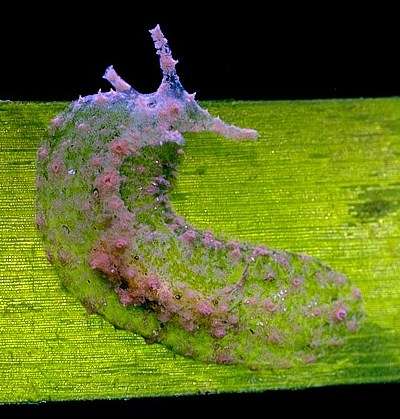
Phyllaplysia spp.
Order: ANASPIDEA
Superfamily: APLYSIOIDEA
Family: Aplysiidae
DISTRIBUTION
Indo-West Pacific.
PHOTO
Koumac Beach (=Baie de Ouanap), near Koumac, New Caledonia, 20°34'S, 164°16'E, Mixed soft and hard substrate, grassbeds, algae,
UPPER RIGHT: 13 October 1993, 16mm long alive.
LOWER LEFT: 10 October 1993, 15, 23mm long alive.
LOWER RIGHT: 13 October 1993, 16mm long alive. PHOTOS: Bill Rudman.
These small cryptic, flattened aplysiids are quite common in tropical and sometimes temeperate waters living on the flattened leaves of marine plants. How many species and genera there are has been the subject of a lengthy, and uninformative debate in the scientific literature.
There are two morphologically similar genera, Phyllaplysia and Petalifera. Bebbington (1972) states that the two genera are often confused but can usually be distinguished by the absence of a shell in adult Phyllaplysia. However in the same paragraph he cites Beeman (1968) who considers the presence and absence of a shell is not a useful character. The following authors have contributed to, but unfortunately not yet clarified, the debate: Engel, 1936., Eales, 1944, 1960a,b., Baba, 1959c., Marcus, 1972., Beeman, 1970., Bebbington, 1972, 1974, 1977. Within the `Petalifera petalifera' species group, Engel considered there to be one worldwide species which could be separated into many geographic races or subspecies. Baba (1959c), without discussion, decided there were at least four species in Japanese waters, and subsequently some authors have proposed more new species while others have recognised a single circumtropical species, P. petalifera (Rang, 1828). Very few of these studies are based on more than a few specimens.
One species which is easily separable is Petalifera ramosus. All other 'species' seem to be flattened and cryptic like the animals illustrated here.
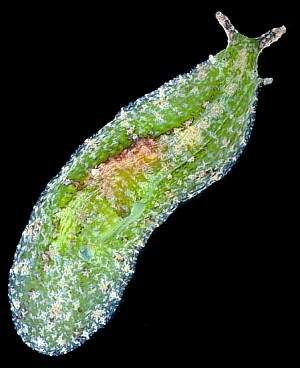
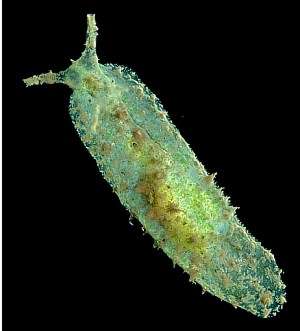
Rudman, W.B., 2000 (February 16) Phyllaplysia spp. [In] Sea Slug Forum. Australian Museum, Sydney. Available from http://www.seaslugforum.net/find/phyllaply
Related messages
Re: Phyllaplysia from Sulawesi
April 11, 2006
From: Dong Bum Koh
Dear Bill,
Concerning the message about Phyllaplysia from Sulawesi.(#16218 )
How about Elysia trisinuata? We can see three parapodial folds on dorsum.
Best regards,
Dong Bum Koh
drkoh@seasee.co.kr
D.B.Koh, 2006 (Apr 11) Re: Phyllaplysia from Sulawesi. [Message in] Sea Slug Forum. Australian Museum, Sydney. Available from http://www.seaslugforum.net/find/16246Dear Koh,
It certainly has some elysiid characteristics, but sacoglossans only have one pair of head tentacles. This animal has two pairs of enrolled tentacles, and a sperm groove on the right side of the head, which makes it a sea hare.
Best wishes,
Bill Rudman
Phyllaplysia from Sulawesi
April 5, 2006
From: Roberto Sozzani
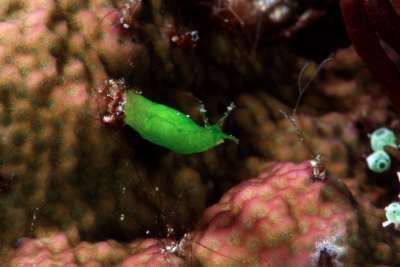
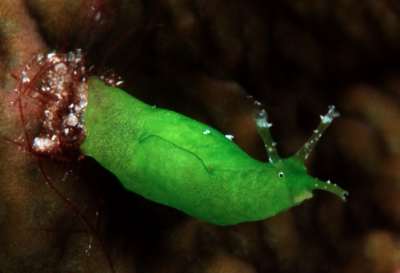
Dear Bill,
Could this animal be a Petalifera? Looks very similar to Petalifera ramosa, but the body is very smooth and missing the typical colored pattern.
It was in a strange position, almost perpendicular to the coral wall: I was attracted by the nice green color, thinking it could be an unusual colored ascidian. Once closer I realized it was something I had never seen before.
Locality: Walea Island - East Sulawesi, 15 metres, Indonesia, Pacific Ocean, August 2004, Coral reef. Length: 6 cm. Photographer: Roberto Sozzani.
Thanks for any suggestion.
Best wishes
Roberto Sozzani
www.robertosozzani.it
roberto.sozzani@fastwebnet.it
Sozzani, R., 2006 (Apr 5) Phyllaplysia from Sulawesi. [Message in] Sea Slug Forum. Australian Museum, Sydney. Available from http://www.seaslugforum.net/find/16218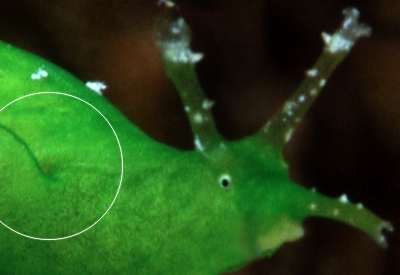
Dear Roberto,
I was almost fooled into thinking this was the Halimeda-feeding sacoglossan Elysiella pusilla, when I suddenly noticed it had two pairs of head tentacles instead of the one pair found in sacoglossans. You can also just make out the genital opening and the start of the sperm groove which runs out to just below the right rhinophore [see Aplysiid head Fact Sheet]. So I agree this is a Sea Hare aplysiid but it is most probably a species of Phyllaplysia not Petalifera. It certainly does look our of place.
I'm afraid the phyllaplysiids in the Indo-West Pacific have never been properly studied so I am putting them all on a Phyllaplysia spp page. ['spp' with 2 'p's is just shorthand from species plural].
Best wishes,
Bill Rudman
Phyllaplysia from Botany Bay, eastern Australia
December 5, 2005
From: Donald Miles
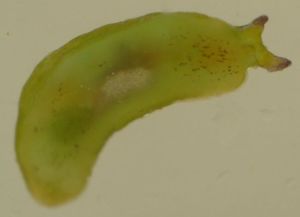
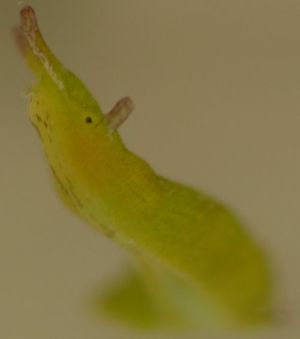
I am hoping that someone will be able to identify this little green slug that we found. It was photographed in a plastic container, so I have included one shot of its underside and another of its head.
Locality: Silver Beach, Bonna Point , Kurnell, Botany Bay, NSW, Australia.
Depth: 1 - 2 metres. Length: 15 - 20 mm. 30 November 2005. Intertidal sea grass beds. Photographer: Donald Miles
Thanks,
Don Miles
AUSECO
auseco@optusnet.com.au
Miles, D.W., 2005 (Dec 5) Phyllaplysia from Botany Bay, eastern Australia. [Message in] Sea Slug Forum. Australian Museum, Sydney. Available from http://www.seaslugforum.net/find/15399Dear Don,
This is a small Sea Hare of the genus Phyllaplysia, a name meaning 'leaf aplysia', which is very appropriate for these small animals which are very camouflaged on the sea grasses and other plants they live on. Unfortunately the taxonomy of this group, is in a mess. Colour is one of the few characters we have to use, but we have very few samples of the live animals worldwide, and they seem to be quite variable in colour within a single population. I am accumulating the Indo-West Pacific records we have on a Phyllaplysia spp page.
Best wishes,
Bill Rudman
Phyllaplysia? from Kerama Id
July 20, 2002
From: Atsushi Ono
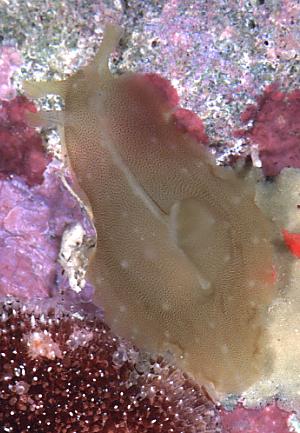
Dear Bill,
Attached is a species similar to Phyllaplysia padinae. I found 3 specimens at a same spot. These are same size and same in color (many dark dots). The shape of this species looks like that of Dolabrifera dolabrifera, but I have never seen a color form like this.
I can see some papillae(a few with multiple tips) and a shell, small dark brown mottle and a larger white patch.
15mm long, on the rope of a fish preserve, at Kerama Is. near Okinawa.
Sincerely,
Atsushi Ono
ononini@cosmos.ne.jp
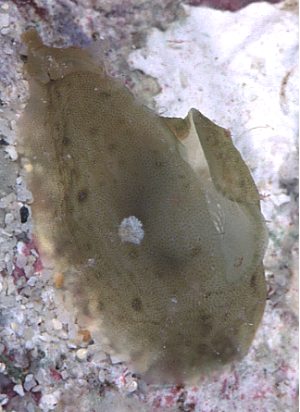
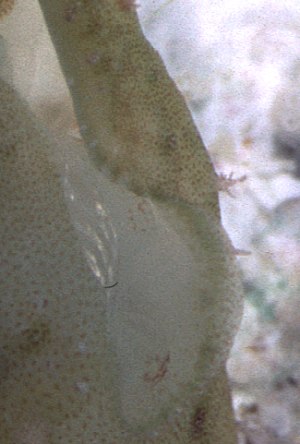
Dear Atsushi,
It does indeed look very like P. padinae. Unfortunately we know very little about this group of Sea Hares in the Indo-West Pacific so it is very difficult to suggest names for them. I think at present it best just to accumulate them on this Phyllaplysia spp. Page until someone revises them for us.
Best wishes,
Bill Rudman
Phyllaplysia from Sydney, Australia
February 4, 2002
From: Andrew Trevor-Jones

Bill,
I found a couple of sea hares in one of my aquariums which I believe are Dolabrifera dolabrifera. These molluscs have the standard head of a sea hare - anterior tentacles plus rhinophores and the body is very much flattened as in the pictures on the forum. Both sets of tentacles seem more cylindrical than some of the pictures of this species in the forum.
I have not yet got a good photo of the dorsal surface, but have attached a couple of pictures of the venteral surface which show that the foot is nearly transparent. One of the photos shows two sea hares copulating. While there is a small amount of live rock (coral rubble) in the tank, I have been collecting samples of sand from in around sea grass beds around Sydney Harbour (Balmoral and Camp Cove) and I suspect it is from here that the sea hares were introduced.
Can you please confirm my assumption on the species?
Many thanks,
Andrew.
atj777@attglobal.net
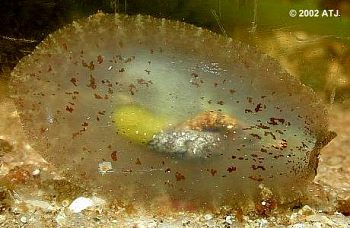
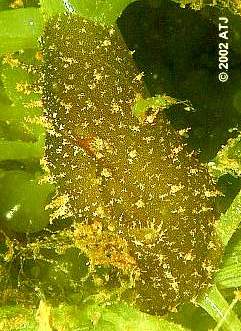
Dear Andrew,
You animals are indeed aplysiids but they belong to Phyllaplysia, which is another genus of the Sea Hare. The transparent and flattened sole of the foot is rather different from Dolabrifera which usually crawls in a leech-like fashion, stretching out its head, attaching it to the substrate, then dragging the posterior part of the body forward. They are probably a good thing to have in the aquaria as they shpuld keep algal growth down and won't grow as big as a species of Aplysia.
Phyllaplysia is often found on sea grasses and is remarkably well camouflaged. Unfortunately too little work has ben done on the group for us to be sure how many species there are and how to tell them apart so at the moment I and just lumping them all as Stylocheilus spp which is just a shorthand way of saying Stylocheilus species (plural) as distinct from Stylocheilus sp which means Stylocheilus species (singular).
Bbest wishes,
Bill Rudman
Phyllaplysia from SE Sulawesi
February 19, 2000
From: Lindsay Warren

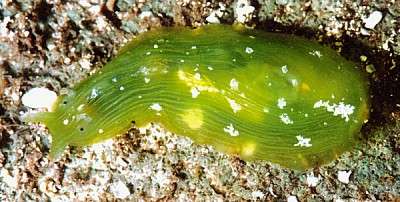
Dear Bill
I have another query about the attached which we believe to be a species of Petalifera. We found these quite commonly at night, usually when wading at low tide although also when diving at high tide in the same area. They were found on the blades of sea grass on which they are well camouflaged. They are quite flat and adhere very firmly to the sea grass.
Towards the rear of the parapodia and protected by them one can sometimes see the translucent green gills. Over the dorsum are irregular patches of white which are often raised into a hook-like projection (soft). The rhinophores are relatively small and eye spots are clearly visible in front of them. OS0752 measured 30 mm while OS0651 measured 13 mm. Once tuned into them, we found them whenever we looked for them from August through to the end of November 1999. [Tukang Besi, S.E.Sulawesi, Indonesia - Operation Wallacea]. Photos: Lindsay Warren
All the best
Lindsay Warren
100014.2112@compuserve.com
Warren, L., 2000 (Feb 19) Phyllaplysia from SE Sulawesi. [Message in] Sea Slug Forum. Australian Museum, Sydney. Available from http://www.seaslugforum.net/find/1916Dear Lindsay,
See my comments at the top of this page concerning the names Petalifera and Phyllaplysia. I am afraid I find trying to identify species too confusing to try. Which is disappointing because they are fascinating little animals.
Bill Rudman.
Rudman, W.B., 2000 (Feb 19). Comment on Phyllaplysia from SE Sulawesi by Lindsay Warren. [Message in] Sea Slug Forum. Australian Museum, Sydney. Available from http://www.seaslugforum.net/find/1916